JAWS, Then and Now
Even in their earliest days, sharks showed some remarkable variations
on their basic structural theme. Ancient sharks differed from their
modern descendants in several important respects:
|

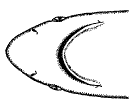 The snout of a Devonian shark was typically short and rounded,
and the jaws were longish and located at the front of the head. In
modern sharks, the snout is typically longish and pointed, the jaws
shorter and located underneath the head. Long jaws are structurally
weaker than short ones and less able to produce a powerful bite, so
early sharks may have plucked prey from the bottom or 'on the fin'
with forceps-like delicacy.
The snout of a Devonian shark was typically short and rounded,
and the jaws were longish and located at the front of the head. In
modern sharks, the snout is typically longish and pointed, the jaws
shorter and located underneath the head. Long jaws are structurally
weaker than short ones and less able to produce a powerful bite, so
early sharks may have plucked prey from the bottom or 'on the fin'
with forceps-like delicacy.
|
|
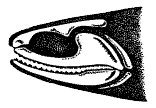
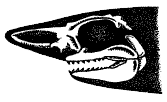 Early sharks' upper jaws were fixed to the braincase at both the
front and the back (the so-called 'amphistylic' form of jaw
suspension), unlike most modern sharks in which the upper jaw is fixed
to the braincase at the back only ('hyostylic' jaw suspension). As a
result, ancient sharks may have been less able to protrude their jaws
than modern sharks, reducing their ability to suck prey into their
mouths and restricting the size of their food.
Early sharks' upper jaws were fixed to the braincase at both the
front and the back (the so-called 'amphistylic' form of jaw
suspension), unlike most modern sharks in which the upper jaw is fixed
to the braincase at the back only ('hyostylic' jaw suspension). As a
result, ancient sharks may have been less able to protrude their jaws
than modern sharks, reducing their ability to suck prey into their
mouths and restricting the size of their food.
|
|
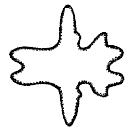
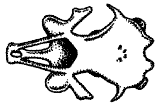 The braincase and olfactory capsules (which house the scent
organs) of ancient sharks were relatively small, suggesting that they
had a lesser brain and less well-developed sense of smell than their
modern descendants. Smaller brain size may also indicate that their
other senses were less acute, predatory behavior less flexible, and
social dynamics lgess sophisticated than in most modern sharks
(especially the whalers and hammerheads).
The braincase and olfactory capsules (which house the scent
organs) of ancient sharks were relatively small, suggesting that they
had a lesser brain and less well-developed sense of smell than their
modern descendants. Smaller brain size may also indicate that their
other senses were less acute, predatory behavior less flexible, and
social dynamics lgess sophisticated than in most modern sharks
(especially the whalers and hammerheads).
|
|
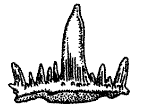
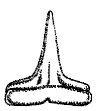 The teeth of the earliest sharks were smooth-edged and
multi-cusped, with a large central blade flanked by two or more
smaller cusplets on either side (a tooth type termed cladodont,
meaning 'branch-toothed'). Although some of the more conservative
modern sharks (such as the six- and seven-gills, nurse sharks and
smoothhounds) have multi-cusped teeth, the most recent forms (such as
whalers, hammerheads, and the white shark) typically have
single-cusped teeth often with serrations. Cladodont teeth are best
suited to grasping prey that can be swallowed whole; whereas the
sharp-edged or serrated single-cusped teeth of modern sharks opens new
dietary options, enabling them to gouge pieces from food items too
large to be swallowed whole.
The teeth of the earliest sharks were smooth-edged and
multi-cusped, with a large central blade flanked by two or more
smaller cusplets on either side (a tooth type termed cladodont,
meaning 'branch-toothed'). Although some of the more conservative
modern sharks (such as the six- and seven-gills, nurse sharks and
smoothhounds) have multi-cusped teeth, the most recent forms (such as
whalers, hammerheads, and the white shark) typically have
single-cusped teeth often with serrations. Cladodont teeth are best
suited to grasping prey that can be swallowed whole; whereas the
sharp-edged or serrated single-cusped teeth of modern sharks opens new
dietary options, enabling them to gouge pieces from food items too
large to be swallowed whole.
|
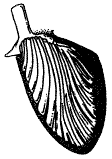
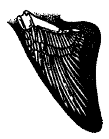 The pectoral fins of ancient sharks were triangular and rigid with
broad bases. In contrast, most modern sharks have falcate, highly
flexible pectoral fins with narrow bases. Therefore, the fins of
ancient sharks were probably somewhat less maneuverable than those of
modern sharks, making them less agile.
The pectoral fins of ancient sharks were triangular and rigid with
broad bases. In contrast, most modern sharks have falcate, highly
flexible pectoral fins with narrow bases. Therefore, the fins of
ancient sharks were probably somewhat less maneuverable than those of
modern sharks, making them less agile.
|
|

 The backbone of ancient sharks was composed of many, relatively
simple vertebrae which were uncalcified and did not constrict the
spinal column. The backbone of most modern sharks contains fewer,
complexly sculpted vertebrae which have calcified bands and constrict
the spinal column at regular intervals. (Exceptions include the
squaloid dogfishes and the six- and seven-gilled sharks, most of which
inhabit very deep waters. It is not clear whether this is due to
retention of primitive characteristics or a secondary adaptation to
their nutrient-poor deep-sea environment.) The poorly calcified
backbone of ancient sharks may have been less able to withstand the
forces generated by the flank muscles, making them less powerful
swimmers than most of their modern descendants.
The backbone of ancient sharks was composed of many, relatively
simple vertebrae which were uncalcified and did not constrict the
spinal column. The backbone of most modern sharks contains fewer,
complexly sculpted vertebrae which have calcified bands and constrict
the spinal column at regular intervals. (Exceptions include the
squaloid dogfishes and the six- and seven-gilled sharks, most of which
inhabit very deep waters. It is not clear whether this is due to
retention of primitive characteristics or a secondary adaptation to
their nutrient-poor deep-sea environment.) The poorly calcified
backbone of ancient sharks may have been less able to withstand the
forces generated by the flank muscles, making them less powerful
swimmers than most of their modern descendants.
|
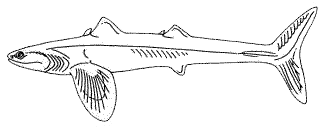 Yet in many respects, ancient sharks were very similar to modern
sharks. Like the sharks of today, ancient sharks had a cartilaginous
skeleton, replaceable teeth, tooth-like scales called 'dermal
denticles', multiple gill slits, two sets of paired fins (pectoral and
pelvic), claspers (the paired, cartilage-supported copulatory organs
of male sharks,
Yet in many respects, ancient sharks were very similar to modern
sharks. Like the sharks of today, ancient sharks had a cartilaginous
skeleton, replaceable teeth, tooth-like scales called 'dermal
denticles', multiple gill slits, two sets of paired fins (pectoral and
pelvic), claspers (the paired, cartilage-supported copulatory organs
of male sharks,
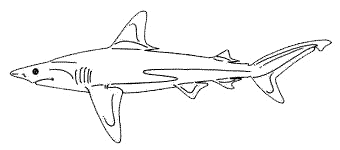 developed along the inner margin of the pelvic fins),
a backbone that extended into the upper lobe of the tail, and a
strongly heterocercal tail fin (more properly called a caudal fin), in
which the upper lobe is considerably longer than the lower.
developed along the inner margin of the pelvic fins),
a backbone that extended into the upper lobe of the tail, and a
strongly heterocercal tail fin (more properly called a caudal fin), in
which the upper lobe is considerably longer than the lower.
Thus, sharks are like automobiles: new models come and go, but
certain basic features remain much like those in the prototype. No
point in re-inventing the wheel.
 Yet in many respects, ancient sharks were very similar to modern
sharks. Like the sharks of today, ancient sharks had a cartilaginous
skeleton, replaceable teeth, tooth-like scales called 'dermal
denticles', multiple gill slits, two sets of paired fins (pectoral and
pelvic), claspers (the paired, cartilage-supported copulatory organs
of male sharks,
Yet in many respects, ancient sharks were very similar to modern
sharks. Like the sharks of today, ancient sharks had a cartilaginous
skeleton, replaceable teeth, tooth-like scales called 'dermal
denticles', multiple gill slits, two sets of paired fins (pectoral and
pelvic), claspers (the paired, cartilage-supported copulatory organs
of male sharks,
 developed along the inner margin of the pelvic fins),
a backbone that extended into the upper lobe of the tail, and a
strongly heterocercal tail fin (more properly called a caudal fin), in
which the upper lobe is considerably longer than the lower.
developed along the inner margin of the pelvic fins),
a backbone that extended into the upper lobe of the tail, and a
strongly heterocercal tail fin (more properly called a caudal fin), in
which the upper lobe is considerably longer than the lower.
 The snout of a Devonian shark was typically short and rounded,
and the jaws were longish and located at the front of the head. In
modern sharks, the snout is typically longish and pointed, the jaws
shorter and located underneath the head. Long jaws are structurally
weaker than short ones and less able to produce a powerful bite, so
early sharks may have plucked prey from the bottom or 'on the fin'
with forceps-like delicacy.
The snout of a Devonian shark was typically short and rounded,
and the jaws were longish and located at the front of the head. In
modern sharks, the snout is typically longish and pointed, the jaws
shorter and located underneath the head. Long jaws are structurally
weaker than short ones and less able to produce a powerful bite, so
early sharks may have plucked prey from the bottom or 'on the fin'
with forceps-like delicacy.
 Early sharks' upper jaws were fixed to the braincase at both the
front and the back (the so-called 'amphistylic' form of jaw
suspension), unlike most modern sharks in which the upper jaw is fixed
to the braincase at the back only ('hyostylic' jaw suspension). As a
result, ancient sharks may have been less able to protrude their jaws
than modern sharks, reducing their ability to suck prey into their
mouths and restricting the size of their food.
Early sharks' upper jaws were fixed to the braincase at both the
front and the back (the so-called 'amphistylic' form of jaw
suspension), unlike most modern sharks in which the upper jaw is fixed
to the braincase at the back only ('hyostylic' jaw suspension). As a
result, ancient sharks may have been less able to protrude their jaws
than modern sharks, reducing their ability to suck prey into their
mouths and restricting the size of their food. 
 The braincase and olfactory capsules (which house the scent
organs) of ancient sharks were relatively small, suggesting that they
had a lesser brain and less well-developed sense of smell than their
modern descendants. Smaller brain size may also indicate that their
other senses were less acute, predatory behavior less flexible, and
social dynamics lgess sophisticated than in most modern sharks
(especially the whalers and hammerheads).
The braincase and olfactory capsules (which house the scent
organs) of ancient sharks were relatively small, suggesting that they
had a lesser brain and less well-developed sense of smell than their
modern descendants. Smaller brain size may also indicate that their
other senses were less acute, predatory behavior less flexible, and
social dynamics lgess sophisticated than in most modern sharks
(especially the whalers and hammerheads).
 The teeth of the earliest sharks were smooth-edged and
multi-cusped, with a large central blade flanked by two or more
smaller cusplets on either side (a tooth type termed cladodont,
meaning 'branch-toothed'). Although some of the more conservative
modern sharks (such as the six- and seven-gills, nurse sharks and
smoothhounds) have multi-cusped teeth, the most recent forms (such as
whalers, hammerheads, and the white shark) typically have
single-cusped teeth often with serrations. Cladodont teeth are best
suited to grasping prey that can be swallowed whole; whereas the
sharp-edged or serrated single-cusped teeth of modern sharks opens new
dietary options, enabling them to gouge pieces from food items too
large to be swallowed whole.
The teeth of the earliest sharks were smooth-edged and
multi-cusped, with a large central blade flanked by two or more
smaller cusplets on either side (a tooth type termed cladodont,
meaning 'branch-toothed'). Although some of the more conservative
modern sharks (such as the six- and seven-gills, nurse sharks and
smoothhounds) have multi-cusped teeth, the most recent forms (such as
whalers, hammerheads, and the white shark) typically have
single-cusped teeth often with serrations. Cladodont teeth are best
suited to grasping prey that can be swallowed whole; whereas the
sharp-edged or serrated single-cusped teeth of modern sharks opens new
dietary options, enabling them to gouge pieces from food items too
large to be swallowed whole.
 The pectoral fins of ancient sharks were triangular and rigid with
broad bases. In contrast, most modern sharks have falcate, highly
flexible pectoral fins with narrow bases. Therefore, the fins of
ancient sharks were probably somewhat less maneuverable than those of
modern sharks, making them less agile.
The pectoral fins of ancient sharks were triangular and rigid with
broad bases. In contrast, most modern sharks have falcate, highly
flexible pectoral fins with narrow bases. Therefore, the fins of
ancient sharks were probably somewhat less maneuverable than those of
modern sharks, making them less agile.
 The backbone of ancient sharks was composed of many, relatively
simple vertebrae which were uncalcified and did not constrict the
spinal column. The backbone of most modern sharks contains fewer,
complexly sculpted vertebrae which have calcified bands and constrict
the spinal column at regular intervals. (Exceptions include the
squaloid dogfishes and the six- and seven-gilled sharks, most of which
inhabit very deep waters. It is not clear whether this is due to
retention of primitive characteristics or a secondary adaptation to
their nutrient-poor deep-sea environment.) The poorly calcified
backbone of ancient sharks may have been less able to withstand the
forces generated by the flank muscles, making them less powerful
swimmers than most of their modern descendants.
The backbone of ancient sharks was composed of many, relatively
simple vertebrae which were uncalcified and did not constrict the
spinal column. The backbone of most modern sharks contains fewer,
complexly sculpted vertebrae which have calcified bands and constrict
the spinal column at regular intervals. (Exceptions include the
squaloid dogfishes and the six- and seven-gilled sharks, most of which
inhabit very deep waters. It is not clear whether this is due to
retention of primitive characteristics or a secondary adaptation to
their nutrient-poor deep-sea environment.) The poorly calcified
backbone of ancient sharks may have been less able to withstand the
forces generated by the flank muscles, making them less powerful
swimmers than most of their modern descendants.